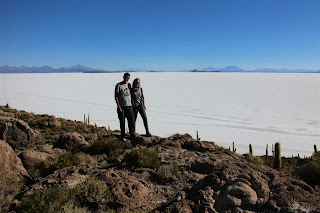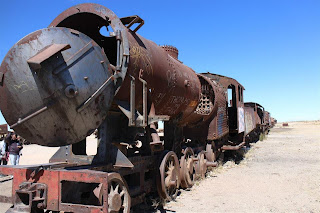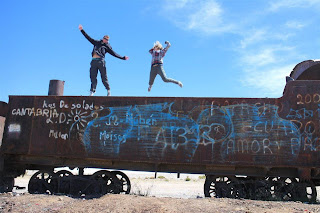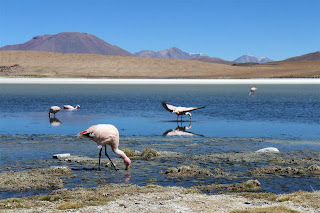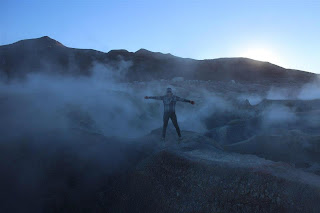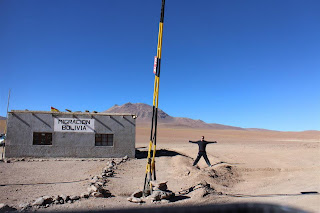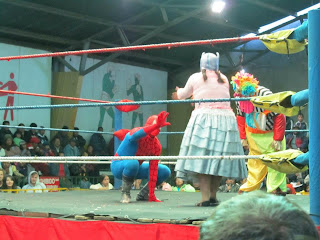 |
| Snorkeling time (in the freeezing cold water). |
Approaching the end of our journey and deciding that we’d come in way under budget (even after staying an extra five months), we decided we could afford to splash out on our biggest treat of the entire trip: an 8 day stint on a boat in the Galápagos.
After our quick little jaunt back up through to Peru, we entered Ecuador and immediately scouting the local travel agencies in Guayaquil for a trip to the Galápagos. Despite arriving at 5am and running only on fumes, we were out and about first thing and by 9:30am had booked our place on a dinky little tourist boat, the New Flamingo, fit for 10 passengers and 6 crew. The very next morning, we were flying our way to the Galápagos islands, a little over an hour and a half flight from downtown Guayaquil.
We had heard nothing but good things about a visit to these magic little islands from other travellers, and while we weren’t entirely sure what to expect once we arrived, we knew it was going to be something special.
So the Galápagos Islands, huh?
Yep, the Galápagos (the Spanish for Tortoises) is a set of 21 islands and some extra bits located almost 1000km off the coast of Ecuador. The islands, made world famous by Charles Darwin after his Beagle voyage in 1835 at the age of 26, became the basis for his theory of evolution by natural selection.
Contrary to common belief (including ours), the Galápagos archipelago is not a lush, tropical paradise teeming with wildlife, but rather a harsh, arid place, almost completely lacking in fresh water, where very little is able to survive. It is precisely because to few animals can, firstly, safely make the long journey from the mainland (most currents from Central and Northern South America flow past the Galápagos) and, secondly, survive once they get there that there are actually so few species found on the islands. There are only about 600 different types of plants (compared to more than 20,000 found in mainland Ecuador), 22 species of reptiles, less than 100 different species of birds, 400 species of fish and 6 different types of mammals.
 |
| Feeder crab going to town on some algae |
The real interesting aspect of the islands is in its number of endemic species; that is, those found only in the Galápagos. One third of the plants and 20% of the fish are endemic, but over 80% of the reptiles, mammals and lands birds are only found there in the archipelago. Even more, many of the species are found only on one island, despite the animals close proximity to each other. The Galápagos posses 14 types of finches (later called the Darwin finches after his discovery of their uniquely shaped beaks), 14 species of tortoise (almost one species per island, identified easily by their distinctively shaped shells) and 14 types of prickly pear cactus.
The animals and plants have, over time, adapted to their unique environment. Because of the small population of each animal or plant on a given island, any mutations in parents are quickly shared around. Those mutations that increase the rate of survival stick around for longer and then get passed on to future generations, while those that cause the plant or animal to be weaker or more susceptible quickly get terminated.
Our trip
 |
| Who ate the guayaba? |
Our first taste of the Galápagos was the airport on Isla Baltra, the only island in the archipelago that isn’t part of the national park. The screening process here was by far the most intense customs-like experience in South America. Not only had they x-rayed and fumigated all of our bags before we left, they also checked our passports twice and checked all of our paperwork was in order before we were officially allowed onto the islands. After we met our guide and waited around for the other people from our tour to arrive, we were of on a big old bus to the ferry, which took us to Santa Cruz. While waiting on the ferry, we came face to face with the first taste of what life is like in the Galápags: a seal lying in the sun, recovering from a nasty gash in its side, inflicted by one of the many sharks which patrol the waters. It looked pretty serious, but our guide informed us that it was only a flesh wound and the seal would be fine.
That afternoon, we visited a farm in the highlands of Santa Cruz where we saw the Galápagos giant tortoise. The tortoises migrate throughout the highlands and farmers must keep their fences at least a foot off the ground to allow the tortoises to roam freely about their farms. Unfortunately the population of giant tortoises was once around half a million on the Galápagos, but the numbers were decimated by the whalers who frequented the waters of the Galápagos in the 1800s. They would take up to 500 tortoises at a time onto their boats, and store them on their backs in the ships hold. Their unique ability to go months on end without water was their downfall, and the whalers would keep them onboard so they always had a source of fresh meat while they were at sea.
 |
| Trying out tortoise life |
More recently, the introduction of rats, cats and dogs has added to the decline of tortoise numbers as eggs and young (who still have very soft shells) get eaten. The Darwin Centre in Puerto Ayora is doing a great job of increasing the numbers of some of the more endangered species by taking eggs, incubating them and rearing the tortoises until around five years old. At that stage, their shells are strong enough and they can be returned to the islands they were taken from. Survival rates for these eggs is sitting at about 97%, compared to about 5% in the wild and the number of tortoises is finally one the rise.
 |
| Aoife harassing the crabs (actually its just a shell these guys shed, which leaves behind an almost perfectly intact crab-like thing). |
On the second day, we visited San Cristobal Island to see the famous Blue Footed Boobies nesting place. We anchored in a beautiful bay – Punta Pitt – and could see sea lions and turtles under the boat. The water in the Galápagos is crystal clear and couldn’t help jumping from the top of the boat into the water to have a better look at the wildlife. The sea lions were really curious while the turtles just looked bored and would very slowly swim past, just minding their own business.
The small bay had a fairly large sea lion harem and unlike most of the sea lions ignored us the male sea lion constantly patrolled the shore, protecting the young and the females from sharks, or humans if theyre think you’re getting a little too close.
On the third day, we visited Plaza Sur which currently has an over population of land iguanas. The Galapagos hawks, which used to kill the babies and kept the population under control have been wiped out on Santa Cruz, the neighbouring main island, by farmers who were sick of the hawks killing their chickens.
 |
| Land iguana with mating colors on his belly |
The number of land iguanas has since exploded and we had to constantly watch where we stepped in case we were about to stand on one. They traditionally eat cactus fruit, but over competition has led to desperate animals eating crabs or even each other. The male iguanas fiercely protect their cactus tree and prevent any other iguanas, even females, from having any. This changes at mating time, when the male suddenly becomes a lot more generous. We even saw two males fighting it out for territory. One was still in the mating colours because it had stayed much warmer later in the year due to global warming and it´s internal systems got out of sync.
 |
| Clearest water that we’ve seen to date |
To call it a fight is maybe a little bit of an overstatement: they faced each other, nodding their heads in a seemingly aggressive manner, waiting for an opportunity to bite each others tails. We watched for over 20 minutes, but like everything relating to these animals, things happen very slowly, and by the time we left they were still just at this `weigh in` stage – insulting each other and baiting each other to make the first move.
There were also many marine iguanas on the island, and we even saw a hybrid iguana – a cross between a land iguana and a marine iguana. This is not a new species and is unable to reproduce – similar to an ass.
 |
| Swallow tailed gull |
The small lava lizard was also on display. They can change their colour depending on their surroundings, but unlike a chameleon who can change almost instantly, the lava lizard takes up to 15 minutes. Females have a beautiful read throat, which show off by pushing up on their front legs during mating seasons for the boys. The island was also home to many different sea birds. The beautiful swallow tailed gull nested on the rocks, right beside the path. They feed their young and were happy to completely ignore the surrounding tourists.
 |
| Sleep, sleep and more sleep. Sea lions can´t get enough. |
That evening we visited an islet – Mosquera – where we got to see sharks hunting sea lions. One young sea lion got a little too playful and went to bite the tail of a black tip shark. The shark suddenly turned to chase the little guy, forcing him to torpedo himself out of the water to safety, less than a meter away from our friends.
That night we got our torches out, hoping to see some more sharks from the boat. The light attracts fish, which attracts sea lions, which then attracts the sharks. While we didn’t see sharks, we did see a baby turtle, no bigger than 10cm long. They hatch at night and make a run for the water, swimming non-stop for 48 hours in the hope of getting clear of the islands. They need the moon to help navigate, but the lights from the boats often confuse them and they swim towards them instead of further out to sea. Only 5% of the turtles eggs survive to maturity, but this is an apparently healthy number and the Galápagos turtle is not endangered. Compared to their cousins, the tortoises who lay only about 7 eggs, the turtles lay between 80 and 100.
 |
| Flamingos |
On the fourth day after dropping off some of the group who had a shorter trip, and picking up some new people we visited Playa Los Bachas and the flamingo lagoon. We also got to see blue footed bobbies swarming overhead. The males fish together to improve their success rate as they have a softer beak. The females fish alone and have a success rate of close to 35% which is very high.
 |
| Marine iguana on lava |
On our fifth day we visited Sullivan Bay which had a large volcanic eruption just over a hundred years ago. The lava ran over the land and sea for kilometers even joining islands together which were separate beforehand. Very little grows on this lava except some small cacti and some other pioneering plants. Depending on how the lave dried and hardened it created spiky lava called ah-ah (Hawaiian for sore) or smooth lava called ropey as it looks like lengths of rope. From the lava shores the lava heron hunts small fish and the lava lizard blends effortlessly into its black surroundings.
 |
| Little galapagos penguins |
The Galapagos penguin, the second smallest penguin in the world after the blue penguin from New Zealand, also makes its home on the lava. They have built their homes in the lava tunnels left behind when large flows of lava flowed downwards from the volcano to the sea. The lava also created a kind of black coral under the water making it a great snorkeling environment. We got to see some large eagle rays, an octopus, angle fish, puffer fish and hundreds more I can´t name. we also saw some penguins hunting and a lazy turtle just chilling out near the bottom.
That evening we visited Bartolome Island where we got to snorkel with baby white tip sharks very near to the shore. Penguins were also fishing around our feet as we paddled in less than two feet of water. Further out in the murkier water a large white tip was on the hunt. Before sun set we climbed up the crater of the volcano which created Bartolome Island. The view was stunning and gave us a great prospective of all the surrounding islands.
 |
| The Galápagos hawk. |
On the sixth morning we visited Espumilla beach where many turtles come to lay their eggs. Because of this, the island also has a very healthy population of Galapagos hawk which waits on the mangroves by the beach hoping for some unlucky turtles to hatch at the wrong time. The hawks themselves were fascinating and would happily pose for pictures less than a meter away from us.
That afternoon we visited James Bay where there is a fur seal harem. There was also hundreds of marine lizards eating the green algae on the rocks between the high and low tides marks. The males swim 100 meters off shore and dive to 25 meters to feed while the females and young stay close to the shore to feed where they are safe from sharks.
 |
| Sea lion harem |
The male marine iguanas are the only iguanas in the world who can dive and stay under water for up to 30 minutes. They have special glands which collects the sea water and while back on land they spend most of their time sneezing to get rid of the salt. We were also lucky enough to spot a a group of baby iguanas hiding under a rock near the waters edge. Once they are fully grown they will have few predators except sharks and possibly dogs depending on the island but while they are young they can easily be picked off by birds. The lava formation also created pools and waterways which young sea lions use as a safe playground free from the danger of sharks. The curious youngsters, extra brave when in the water, would come right over to the waters edge and try and grab anything we dangled. I nearly lost a flip flop!
 |
| Marine iguana legging it |
That evening we travelled to Rubida island for our last full day. A group of seven bottle nose dolphins decided to joins us and travelled at the head of the boat for 5 minutes or so, jumping out of the water and spraying us. We had seen dolphins and even whales on the distance on previous days but its always an extra treat to see them so close.
 |
| Aoife and the first-mate became besties. |
On our last day we climbed Rubida Island. The island has red sand and because of this it doesn´t have any iguanas or turtles. The red sand heats up too much during the day and would literally cook any eggs laid by the animals. A god example of evolution in action was the cacti, unique to only this island. Because of the lack of iguanas, which is the natural predator of the cactus, the cacti on the island have soft prickles instead of hard as it doesn´t need them to defend itself. That afternoon we had our last snorkeling session and saw some more penguins, sea lions, sharks and rays. Then it was early to bed so we could visit the Darwin centre in the morning before our flight.
The Darwin Centre is on the main island of Santa Cruz and housed up until recently Lonesome George, the last of the Pinta Island tortoise.He died last year. The centre has a number of breeding programs set up with varying success rates. While Lonesom George failed to procreate, Super Diego, an Española Tortoise, has been busily repopulating and is believed to have close to 2000 children.
 |
| Why? I told you: its our guide. |
We left the island that afternoon completely zonked after 8 days of hiking and snorkeling. While it was expensive by South American standards it was definitely worth it. The privilege of seeing evolution at play and interacting with such inquisitive animals was a once in a life time experience, well maybe twice if we can get the money together to go again! We only got to explore a few of the many islands tourists can visit and there is a lot more to see. Only three percent of the islands are open to tourists, with the park constantly changing the landing areas around to rest some of the spots. Only recently a new species of finch has been classified and everywhere animals, in their daily struggle for survival are adapting and changing.
 |
| Our boat mates |
While the increasing number of visitors is having a negative affect, particularly in Puerto Ayora (the biggest town in the Galapagos with over 12,000 inhabitants – people continue to flock from the main land hoping to work in tourism), tourism is also the best chance the Galapagos has for survival. Ecuador has one of the worst environmental records out of all of the South American countries but in general seems to be doing a good job of conservation in the Galapagos because of the lucrative tourism it brings in.

































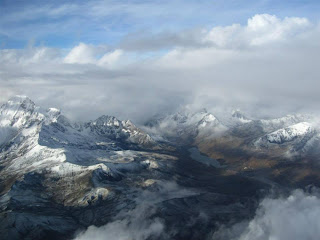








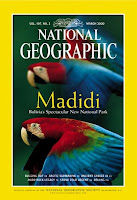



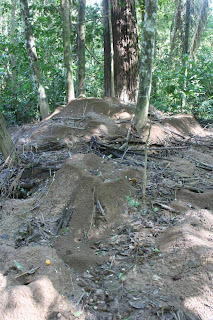

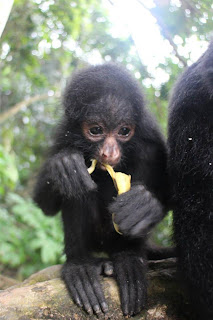


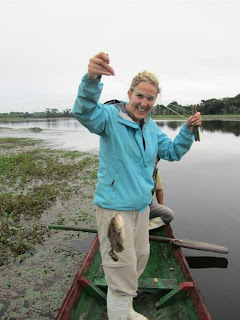


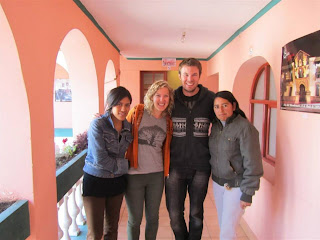




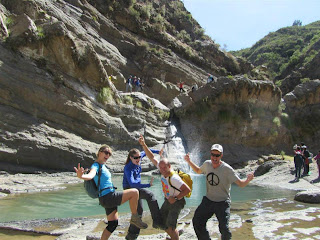
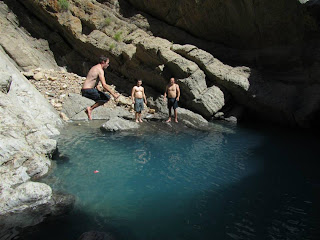





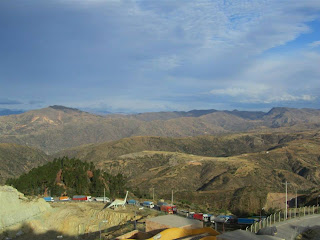
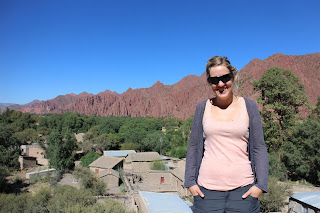.jpg)
.jpg)


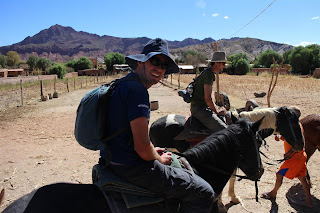

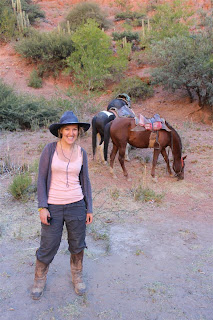
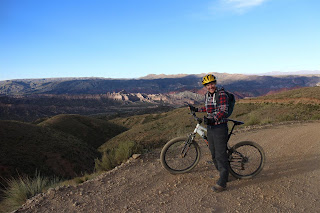
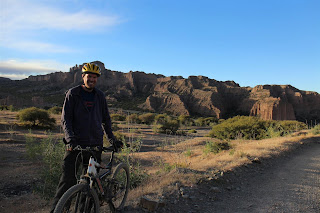.jpg)
